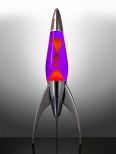The sixties was a revolutionary era, responsible for many social and cultural developments which were previously a taboo. Although many trends have come and gone since, one item has remained popular until this day, mesmerising the nation for over 50 years. The Lava Lamp.
Invented in 1963 by Edward Craven Walker, the lava lamp is particularly intriguing, perhaps because no lamp is ever the same. This interest inspired me to delve deeper into the working of the lava lamp and explore the dynamics that allow the fluids to flow as they do.
The lamp contains multiple substances housed within an elongated glass container; water, paraffin wax, mineral oil and an inorganic compound more dense than water. Originally the compound used was carbon tetrachloride but in recent years this has been substituted for a less toxic, secret compound. For the purpose of my blog I shall model the workings of the lava lamp using carbon tetrachloride.
| Density (kg/m3) | Melting Point (degrees Celsius) | Boiling point (degrees Celsius) | |
| Water | 1000 | 0 | 100 |
| Paraffin wax | 900 | 47-65 | >370 |
| Carbon tetrachloride | 1590 | -22 | 76 |
As you can see, the density of paraffin wax is lower than that of water and would therefore float in the water, hence why we introduce our inorganic compound, carbon tetrachloride. This substance is more dense than the water which is why we add it to the wax. The base of a traditional lava lamp contains a 40 watt light bulb which begins to heat the substances above. As the temperature increases to approximately 50 degrees Celsius the density of the wax mixture becomes less than the water. We must note that the water and wax are miscible (they do not mix) and therefore the wax becomes a fluid and small droplets rise to the top of the lamp before cooling and descending.

A fluid undergoing Rayleigh-Taylor instability. (Media from http://ffden-2.phys.uaf.edu)
The underlying fluid mechanics behind the lava lamp can be explained by convection and instability theorems. Firstly we shall explore the Rayleigh- Bénard convection phenomenon. This is a fluid flow due to a temperature distribution in a plane which is heated from below. The lower density fluid, in our case the wax mixture, ascends from the warmer bottom. In the convection process an increase in temperature causes an increase in viscosity and so the wax becomes more viscous (easily flowing).
The theory of Raleigh- Taylor instability is also demonstrated in the lava lamp. It is where two fluids are in contact, with the less dense fluid below pushing up on the more dense fluid. This can be seen when the wax mixture (originally heavier) is heated and becomes lighter than the water and pushes upwards.
Although the lava lamp is a simple model it visually displays a number of fluid concepts. Perhaps when you next set eyes upon one, you’ll consider the applications of the mechanics behind it, or maybe once again you’ll just be too hypnotized to let all of that sink it.

